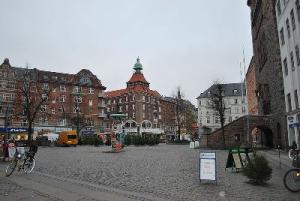Consequences of Prohibition
Drug War Issues
A private safe injection site for heroin users is set to open in Copenhagen this week despite warnings from police and over the objections of neighbors. The harm reduction operation will be located in the city's Vesterbro district near Central Station. It will be the first in Denmark.

Copenhagen's Vesterbro district (Image via Wikimedia)
But safe injection site organizer Michael Lodberg Olsen said there was nothing illegal about it. "If that's the case, then they could just as well have shut down all of Vesterbro 30 years ago," he said, referring to needle exchange programs that have operated there for decades. "A report from the UN states that handing out clean needles to drug abusers is the same as establishing an injection room," he said.
Safe injection sites are already operating in Australia, Canada, Germany, Luxembourg, the Netherlands, Norway, and Spain. There are no safe injection sites in the US, although there has been talk about establishing one in San Francisco.
This work by StoptheDrugWar.org is licensed under Creative Commons Attribution-ShareAlike 4.0 International
Comments
isnt that the point
last time i checked I am pretty sure safe injection sites are there so people can go and shoot up isnt that the whole point. If they aren't allowed to inject there then why go there just for a clean needle when if your an heroin addict you probably wont care enough to go get a needle and then go back home to shoot up i would say forget that i rather use my dirty needles so to get my fix faster. the whole point is to go there to have not only a clean needle but a doctor on site just incase of overdose and to monitor them.
In reply to isnt that the point by TJ (not verified)
I believe the whole point of
I believe the whole point of any program of this nature is to try and combat the transmission and spread of HIV and AIDS not condone the use of illegal drugs. They are looking at the overall health of the population because drug users/abusers are not kept separated from the rest of society.
From just 2240 in 1968 to well over 200,000 now.
In the UK, there were only 94 heroin addicts registered on the Home Office Index in 1960. Some observers ascribed this low number to the so-called ‘British System’, which allowed addicts to receive prescriptions from doctors, and argued that this prevented an illegal market becoming established in the country.
However, there was a substantial increase in the number of registered heroin addicts in the 1960s (2240 in 1968).
The government set up a new Committee, chaired by Sir Russell Brain, to look into the situation. The report published in 1961 concluded that there should be no major departure of the recommendations of the 1926 Rolleston report.
However, the Committee reconvened due to the 'perceived' deteriorating situation and published a second report in 1965.
This second report confirmed the basic Rolleston Principle that a doctor, acting in good faith, should be allowed to prescribe addictive drugs to an addict. It reasserted that ‘the addict should be regarded as a sick person, he should be treated as such and not as a criminal, provided he does not resort to criminal acts.’
However, the 2nd Brain Report also made recommendations that restricted prescribing to doctors specially licensed by the Home Office and practising from agreed premises.
Special NHS clinics were set up in 1967 that prescribed heroin. From 16th April 1968, ordinary medical practitioners could no longer prescribe heroin to addicts.
Over the next ten years or so, following pressure from the US, these NHS clinics shifted over to prescribing oral methadone, rather than heroin. The level of heroin prescribing has been extreamly low ever since.
The rate of increase in registered heroin addicts was fairly slow during the 1970s, but grew rapidly during the 1980s – the so-called 1980s heroin epidemic. This increase in addiction coincided with the decision to prescribe oral methadone, rather than heroin.
The number of addicts known to the Home Office (mostly heroin addicts) grew from 2,400 in 1979 to around 18,000 in 1990 and almost 45,000 by 1996.
The total number of problematic heroin users in the UK is now thought to be well over 200,000, but such estimates are acknowledged to be imprecise.
Add new comment